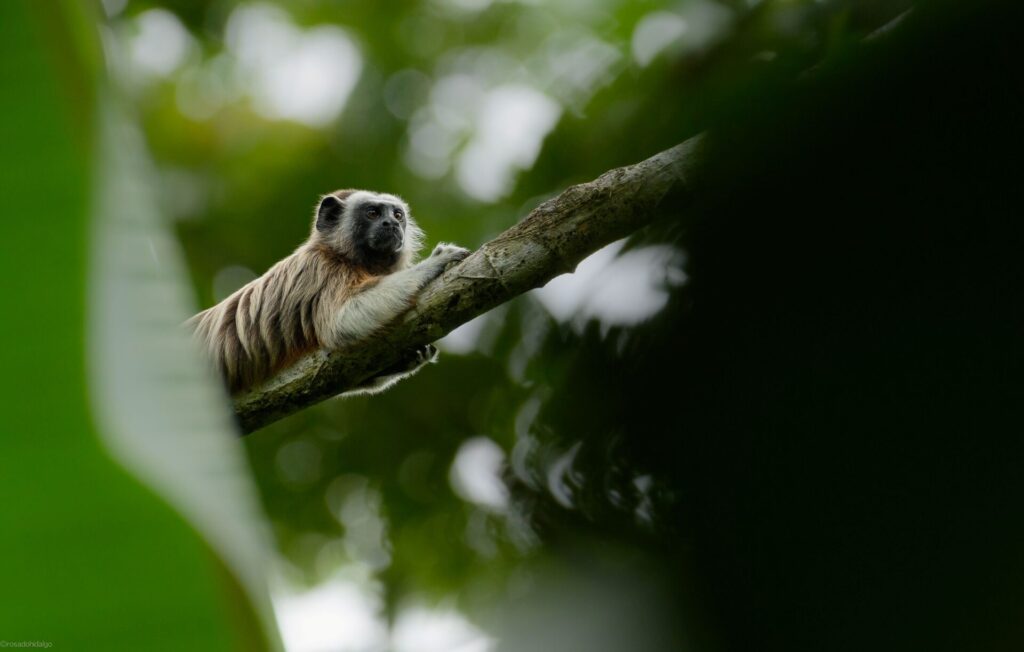Found only in Colombia, the White-footed Tamarin (Saguinus leucopus) is a fascinating and little-known inhabitant of Colombia’s Middle Magdalena Valley.
To learn more about this squirrel-sized monkey, we spoke with Juan David Sánchez, Coordinator of Conservation Management and Research at Fundación Biodiversa Colombia (FBC), who has extensively studied this remarkable primate in FBC’s El Silencio Reserve.
The unusual social behaviour of the White-footed Tamarin captivated the interest of FBC biologist Juan David Sánchez. Credit: FBC
Could you tell us about the White-footed Tamarin and how your interest in them began?
“My interest in this species is broad, as mammals in general have been my principal study group. The White-footed Tamarin, locally known as the tití gris, was one of the first species I studied across different sites in its range. It is both unique and geographically restricted, occurring only on the western side of the Middle Magdalena Valley and in some foothill forests in the Cordillera Central: the highest of the three branches of the Colombian Andes.
The species is fun to watch due to its behaviour and fascinating group structure, which typically includes a breeding pair and offspring of different ages. They defend territories of around 10 hectares (25 acres) as they forage for fruits, flowers, lizards, frogs, and insects. Although they can survive in altered landscapes, their distribution is limited, while they thrive in intact and especially old-growth forests.”
The Middle Magdalena Valley offers a vital forest refuge for the White-footed Tamarin, which thrives in large unbroken habitats. Credit: FBC
Could you share a memorable encounter you’ve had with this species in El Silencio Reserve?
“There are several groups living throughout the reserve, even in young secondary forest. One group regularly passes near one of our camps. While trying to photograph them once, I misjudged my footing and fell through some loose planks on a bridge crossing a little stream. My attention was so firmly focused on the tamarins that I wasn’t watching where I was going! I like to think that the tamarins were amused.”
What is something particularly fascinating about this species for you?
“They have a very interesting reproductive behaviour, whereby the dominant female in a group suppresses the reproduction of subordinate females by releasing pheromones that inhibit their ovulation. Rather than mating, these subordinate females help care for the dominant female’s young, acting as cooperative “helpers” or nursemaids. It is a remarkable social strategy and, within primates, is quite unique to marmosets and tamarins. Beyond primates, a similar system is known in meerkats.”
The White-footed Tamarin has a very interesting reproductive system where young females cooperate in the raising of the young. Credit: FBC
What threats do they face, and how will the appeal help?
“Habitat loss is the major threat. Without continuous habitat, the species’ long-term viability becomes uncertain. This campaign will help expand the El Silencio Reserve and create essential connectivity between forest fragments and larger protected areas by contributing towards the future connection of the El Silencio Reserve and the San Bartolo Civil Society Nature Reserve. This purchase is a key step towards connecting over 6,000 hectares (14,826 acres) of continuous forest habitat, allowing greater movement and genetic exchange between tamarin populations.”
What would the success of this campaign mean to you?
“Success would be a landmark achievement for regional conservation – a model for connecting fragmented forests in a region that currently lacks nationally protected areas. It will also help safeguard the Barbacoas wetlands and set a precedent for future conservation in this region, protecting not only the White-footed Tamarin but also a whole host of other extraordinary species which call these forests home.”
Act now to support our autumn appeal and safeguard this rare monkey before it is too late.

